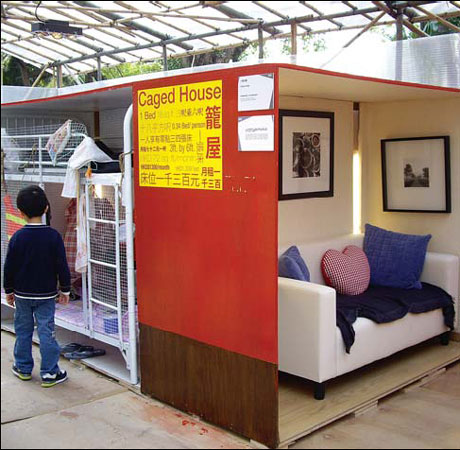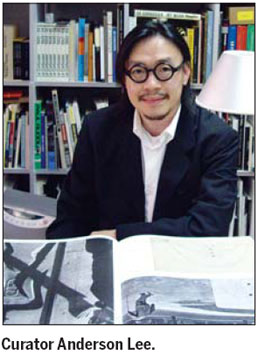
 |
|
A Bed of Life by the Young Planners Group Committee. Photos by Rebecca Loo / For China Daily |
Interactive exhibits and creative interpretations of bunk beds make the Hong Kong portion of the Bi-City Biennale worth a second look. Rebecca Loo takes a stroll through.
The Hong Kong Shenzhen Bi-City Biennale of Urbanism/Architecture gives a stroll in the park a whole new meaning. This year, the Hong Kong portion takes advantage of the natural greenery of Kowloon Park and the historic Heritage Discovery Centre.
The site contains a number of freestanding pavilions with internationally renowned firms, such as Kohn Pederson Fox (KPF), Morphosis, Steven Holl and MVRDV, showcasing exhibits side by side with Hong Kong's Kacey Wong and Shanghai-based Neri &Hu.
One of the most compelling installations is A Bed of Life, a four-part cube illustrating how different strata of Hong Kong society live within the same space. From luxurious furnishings to caged beds, the Young Planners Group Committee shows that grass may be greener, but it isn't necessarily bigger.

First presented in 2007, the biennale showcases works commissioned specifically for the event by professionals in the fields of architecture, design and planning.
Although Shenzhen and Hong Kong each hosts completely different shows with different curators and exhibitors, a cultural dialogue was forged between them and continues to grow. The Shenzhen portion of the biennale, held at Shenzhen Civic Square and OCT Loft, concluded on Feb 18.
This year is the first time the Hong Kong portion of the biennale was co-curated by a non-Hong Kong resident. Taiwan architect Gene King collaborated with Hong Kong's Anderson Lee as chief curator. The two had never met prior to becoming co-curators, but they found that they had similar backgrounds and ideals.
"With Gene, the Taiwan aspect of the biennale was very evident for the first time," Lee says. Taipei got its own pavilion to one side of Heritage Discovery Centre's courtyard and there are a number of small wooden houses that invite visitors to peep inside.
The curatorial team was selected by the biennale's organizers: The Hong Kong Institute of Architects, the Hong Kong Institute of Planners and the Hong Kong Designers Association. CreateHK was the event's major sponsor.
This year's concept of "Tri-ciprocal Cities: Time, Place and People" uses the number 3 as a key motif.
"What drove the biennale was an idea," explains Lee, who worked on the biennale for the past six months while juggling his duties as a design professor at The University of Hong Kong's Faculty of Architecture and managing director of Index Architecture.
"We were trying to tell stories from different cities around the world. We separated the pavilions into different geographical regions with young cities alongside mature ones. We tried to balance young architects with more established ones."
Kowloon Park was selected by the curators as the best site primarily due to its central location. It is a public space in a major tourist area easily accessible by public transit, ensuring that it will draw people who don't normally attend exhibitions.
Its major disadvantage is a limited amount of interior spaces.
(Kowloon Park sits between the busy Tsim Sha Tsui Nathan Road main shopping artery and the Harbor Center/Ocean Terminal blocks.)

The curators faced the choice of limiting the number of exhibitors to the Heritage Discovery Centre, or supplementing the exposition with temporary pavilions scattered throughout the park. They chose the latter and built a series of basic bamboo structures serviced with lighting and electricity. Still, to house 21 exhibitors within the tight confines of Heritage Discovery Centre, parameters had to be set.
"This led to our bunk bed module," Lee says. The traditional 1.85-square-meter bunk bed was given to the international participants chosen for the center. They could deconstruct or embellish it to show their interpretation of 21st century urbanism in their respective cities. The exhibitors in the other pavilions had the bunk bed as an option, but they were not restricted to its parameters as space for them was not a restriction.
"The bunk bed encapsulates our theme," Lee says. "Hong Kong people can immediately understand the context of the bunk bed. The 'space' aspect is our collective memory of growing up in tight spaces. The 'time' alludes to Kowloon Park previously housing military barracks with bunk beds for soldiers."
The interplay of time, place and people formed the "tri" portion of "Tri-ciprocal Cities", which is also a play on reciprocal. "I hope that this tri-alogue will continue long after the biennale is over," Lee says.
The biennale uses outdoor elements already present in the park, such as a maze garden. At its center, an installation dubbed The City of Exchange by Fung Yik-ping, Yung Sai-chun, Chan Ka-shing and Yip Chun-hang is designed like a mini-city with color-coded skyscrapers.
While serious architecture buffs will want to contemplate its deeper meanings, children play on its jungle-gym like qualities. "The biennale isn't meant to be a high art show," Lee says.
The curators received more than 200 entries and voted on which installations should be included. Half of the final exhibits were culled from that selection process. The others were architects and designers they personally invited to contribute creations.
"Famous architects are the easiest to work with!" Lee exclaims. "They already know what's involved when submitting work for a biennale. Gene and I were like conductors, who didn't know what the musicians were playing until we faced the audience on opening night."
Along with the installations, there are events held throughout the biennale both on and off the site that include panel discussions on such topics as architectural conservation, and children's workshops, guided tours and films related to urbanism.
Lee acknowledges the show needs tweaking: Signage could be better, and Kowloon Park's high traffic means that displays suffer from wear and tear quickly. Some of the touch-screen monitors have already taken a beating.
Breathing a sigh of relief at a job well done given the limited budget and time restraints, he feels confident that he can pass the curatorial torch on to the next eager team of architects for the biennale's following installment.
"It was a great opportunity to learn and grow," Lee says. "But I wouldn't want to do it again!"